Metal Stamping
Metal stamping is a precise metal forming process that transforms flat stock sheet metal or metal coils into accurately shaped components using a stamping press (stamp press). This manufacturing technique encompasses a variety of sheet metal forming processes, all contributing to the versatility and efficiency of metal stamp production. These processes include punching, blanking, embossing, forging, bending, coining, and flanging, along with other specialized techniques that enhance the functionality and complexity of stamped metal parts.
Metal Stamping FAQs
What is metal stamping used for?
Metal stamping forms sheet metal or coils into precise components used in industries like automotive, aerospace, defense, and electronics. It produces high volumes of consistent, complex parts with excellent durability and accuracy, ideal for large-scale manufacturing across the U.S. and globally.
Why is metal stamping considered cost-effective?
Metal stamping achieves high production rates with minimal labor and setup costs. Its reusable dies and efficient press systems reduce tooling expenses compared to casting or forging, making it a highly economical choice for high-volume manufacturing operations.
Which materials are commonly used in metal stamping?
Common materials include steel, aluminum, brass, copper, titanium, nickel, zinc, and beryllium copper. Each offers distinct advantages like corrosion resistance, conductivity, and strength, allowing manufacturers to tailor metal properties to specific industrial applications.
What are the main processes involved in metal stamping?
Key processes include blanking, embossing, bending, coining, and flanging. Each technique shapes sheet metal with precision, enabling the creation of both simple and complex components while maintaining high repeatability and tight tolerances.
How does metal stamping support sustainable manufacturing?
Metal stamping minimizes material waste by using less raw metal per part and producing minimal scrap. This efficiency supports eco-friendly manufacturing practices and reduces overall environmental impact in industrial production facilities.
What industries rely most on metal stamping?
The automotive industry is the largest user of metal stamping, followed by aerospace, electronics, defense, and healthcare manufacturing. These sectors depend on precise, durable components that meet strict engineering and safety standards.
What types of stamping presses are used in manufacturing?
Manufacturers use mechanical, hydraulic, progressive, transfer, and fourslide presses. Each type offers unique advantages in speed, pressure control, and complexity, allowing flexibility for parts ranging from small clips to large automotive panels.
How has metal stamping technology evolved over time?
From ancient coin striking to modern CNC-controlled presses, metal stamping has evolved into a highly automated process. Advancements like hybrid electromagnetically assisted stamping have improved efficiency, precision, and cost control in today’s manufacturing environments.
- Cost-Effective
- Metal stamping is an exceptionally cost-effective manufacturing process, capable of producing parts at significantly higher production rates than traditional metal forming methods. The speed and accuracy of metal stamping make it ideal for high-volume production, where increasing production levels lead to reduced labor costs and lower per-piece setup expenses. Many components manufactured through alternative metal forming processes—such as casting, die casting, forging, machining, or fabricating—can be efficiently produced using metal stamping instead. Additionally, metal stamping dies offer a lower tooling cost compared to molds, forging and casting dies, and expendable cutting tools, making the process an economical choice for many applications.
- Precise
- Metal stamping delivers exceptional precision and repeatability, ensuring both standard and complex custom metal stamped parts meet tight tolerance requirements. Precision stamping enhances key aspects such as material flow, deep drawing capabilities, and consistency—features that other metal fabrication techniques struggle to achieve. These benefits are particularly significant in the production of heavier parts, where precision and material integrity are critical.
- High Quality
- The metal stamping process ensures superior accuracy, functionality, wear resistance, and aesthetic appeal in manufactured parts. Stamping allows for the use of tougher and harder materials than many alternative manufacturing methods, enabling production with high-performance metals such as stainless steel, nickel, cold-rolled steel, aluminum, brass, bronze, and galvanized steel. These material options contribute to enhanced durability and performance across various industries.
- Fewer Secondary Processes
- Advanced stamping technology allows a single stamping machine to handle multiple tasks, reducing the need for additional finishing processes. Stamping operations are further optimized with simulation software, enabling prototype designs to be tested and validated before investing in dedicated tooling. By minimizing or even eliminating secondary processes, metal stamping accelerates production timelines and lowers overall manufacturing costs.
- Versatile
- Metal stamping presses, including fourslide presses, can create both two-dimensional and three-dimensional components with continuous or simultaneous stamping, pressing, cutting, and forming. For complex geometries, secondary operations can be integrated directly into the same press and die system. Additional value-added processes—such as nut insertion, automatic stud placement, in-die welding and assembly, and in-die tapping—can be incorporated seamlessly. Furthermore, metal stamping processes can be highly automated when necessary, offering unmatched efficiency and adaptability, making it the preferred choice for a wide range of manufacturing needs.
- More Eco-Friendly
- By requiring less raw material per component, metal stamping supports sustainable manufacturing by reducing material consumption. Additionally, the process generates minimal scrap waste, streamlining disposal and contributing to an overall greener production cycle.
Metal stamping is widely utilized by manufacturers to produce high volumes of uniform, precision-engineered parts at high speeds and low costs. Industries that benefit significantly from metal stamping include automotive, aerospace, military and defense, healthcare, electronics, and research and development.
Among these, the automotive sector represents the largest consumer of metal stamping, followed closely by the consumer electronics industry. Forecasts predict substantial growth in the consumer electronics sector, with an expected compound annual growth rate (CAGR) of 5.4% by 2022. The strong global demand for consumer electronics will further drive market expansion and the adoption of advanced metal stamping solutions.
Additionally, ongoing investments in research and development continue to enhance metal stamping technologies. High-efficiency stamping machines—such as hybrid electromagnetically assisted stamping machines—are improving operational cost efficiency while mitigating production issues such as wrinkling and tearing. These technological advancements are instrumental in driving the continued evolution and growth of the metal stamping industry.
Metal stamping processes create shapes that serve as the foundation for countless products across various industries.
Copper and brass stamped components are widely used in the fabrication of household fixtures, plumbing accessories, and jewelry. Precision brass stampings are essential for manufacturing intricate instruments, including eyelets and gauges, that are critical in aviation. Steel stampings, on the other hand, are often used to produce larger, three-dimensional components, such as automotive stampings. Deep-drawn metal stampings, which result in deep, three-dimensional parts, are commonly used to manufacture everyday products like pots and pans.
Beyond these applications, metal stamping plays a vital role in producing electronic stampings, medical stampings, metal clips, spring clips, lasers, metal brackets, and a variety of structural and functional components. In the automotive sector, external panels such as bonnets, fenders, deck lids, doors, side panels, and roofs, along with internal parts like bonnet interiors, mating panels, door interiors, and deck lid interiors, rely on metal stamping. Additionally, dimensionally critical panels, navigation systems, landing gears, and intricate engine components depend on the precision of stamped metal parts.
Metal stamping is also a cornerstone of modern military technology. Almost every piece of equipment used in contemporary warfare is made possible through precision metal stamping, from helicopters and assault weapons to radio systems and other defense-related machinery.
History of Metal Stamping
Few metalworking processes have had as profound an impact on manufacturing as metal stamping. While it found widespread application in the 20th century, its origins trace back to the earliest human efforts to shape and mold metal after discovering how to extract it from ores.
One of the earliest known applications of metal stamping was coin striking. Archaeological evidence suggests that the first coins were struck in the 7th century BC by the Lydians, an ancient people from what is now Turkey. The Lydians developed a method in which a die with an engraved image was placed on one side of a metal blank, while a stamp with another image was positioned on the other side. The entire assembly was then struck with a heavy hammer, imprinting the design onto the coin.
This basic stamping process remained largely unchanged for centuries until the mid-16th century when German silversmith Marx Schwab revolutionized the industry. Around 1550, Schwab invented a screw press that could mold metal into coins using a die. This press, which required up to twelve men to operate, laid the foundation for modern precision metal stamping.
The true rise of metal stamping, however, occurred during the Industrial Revolution. Manufacturers began using the technique to mass-produce bicycle parts, ushering in a new era of efficiency and cost-effectiveness in manufacturing. As the process continued to evolve, it caught the attention of Henry Ford, the pioneer of the assembly line. Ford's embrace of metal stamping played a pivotal role in making automobiles more affordable, beginning with the production of the Model T.
Today, metal stamping remains a cornerstone of modern manufacturing, shaping everything from spring clips to metal brackets. As industry advancements continue, the role of metal stamping in shaping current and future market trends remains more significant than ever.
Despite recent declines in manufacturing, the U.S. remained the largest market for metal stamping in 2015, with industry revenue surpassing $35 billion. A significant portion of this market share was driven by demand from the conventional automotive sector, while the expanding private aerospace industry also contributed to growth.
According to a report by Grand View Research, Inc., the global metal stamping market is projected to exceed $180 billion by 2022. This expansion will be fueled by the increasing demand for metal stamping in infrastructure projects and the needs of emerging industries. Growth is expected to be particularly strong in developing economies, where industrialization and manufacturing advancements continue to accelerate.
The primary processes in the metal stamping industry include embossing, blanking, bending, fourslide stamping, flanging, and coining. Among these, blanking dominates the global market, followed closely by embossing and bending. Each of these processes plays a crucial role in meeting the evolving demands of key industries.
- Blanking Process
- The blanking sector holds an estimated market value of approximately $30 billion and is poised for substantial growth. This increase is largely driven by rising demand in the aerospace and automotive industries, where precise and high-volume production is critical. The ability of blanking to efficiently create uniform, high-quality metal components positions it as an essential process in modern manufacturing.
- Embossing Process
- Embossing accounts for over 21% of all metal stamping activities and continues to grow as a result of rapid industrialization in key markets such as China, India, and Brazil. The embossing process enhances product design and functionality, making it an integral component of industries that require decorative and functional surface modifications. As manufacturing capacities expand in these regions, embossing is expected to play a greater role in shaping metal components for various applications.
- Bending Process
- The bending process is also on track for significant growth, driven by strong demand across multiple end-use industries. Its operational advantages—such as adaptability to metal thickness variations, easy adjustability, and optimized tonnage requirements—make it a preferred choice for manufacturers looking to enhance efficiency and precision. As industries continue to seek advanced forming techniques, the bending process is expected to remain a cornerstone of metal stamping production.
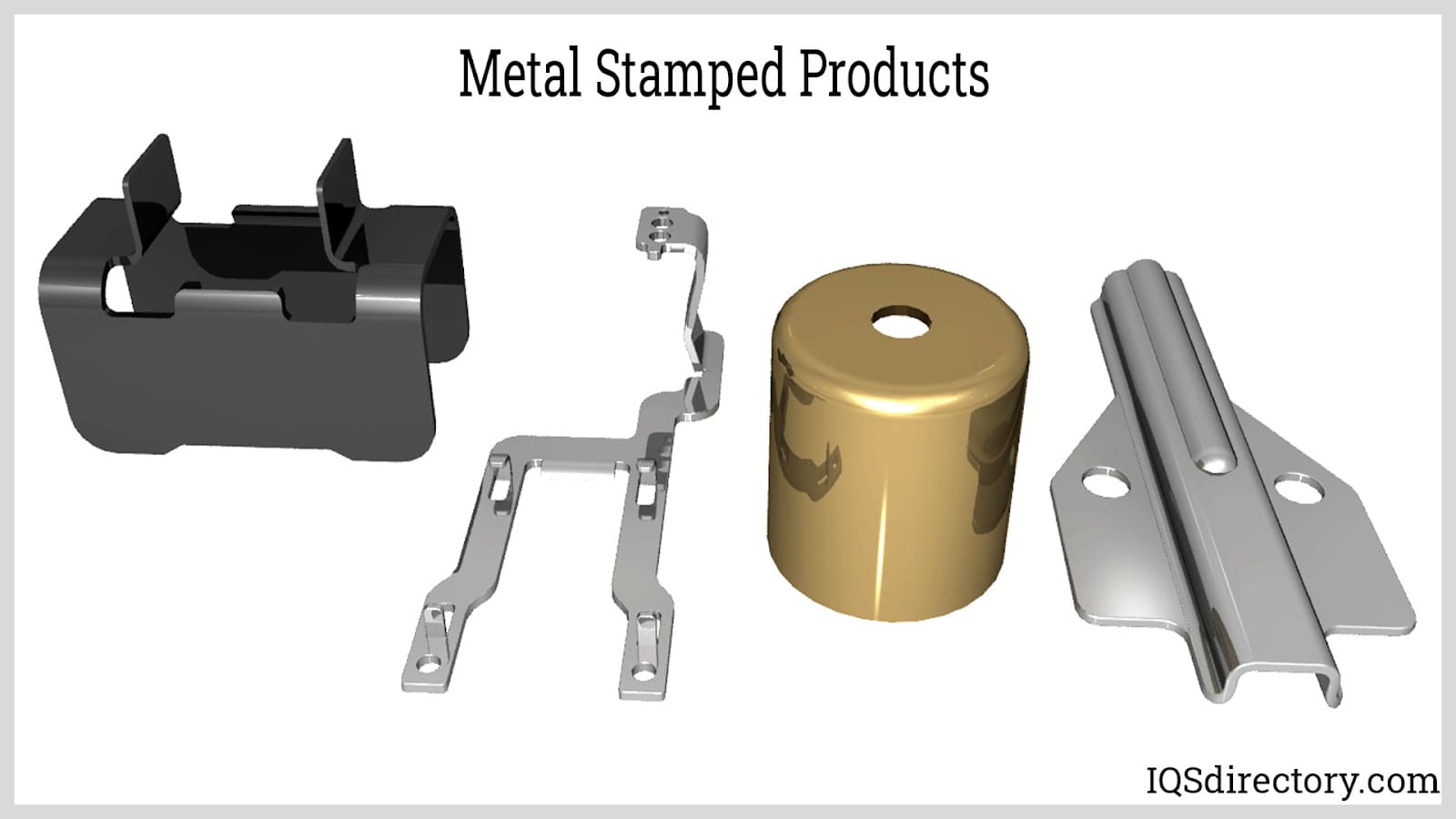 Examples of proedust made from metal stamping.
Examples of proedust made from metal stamping.
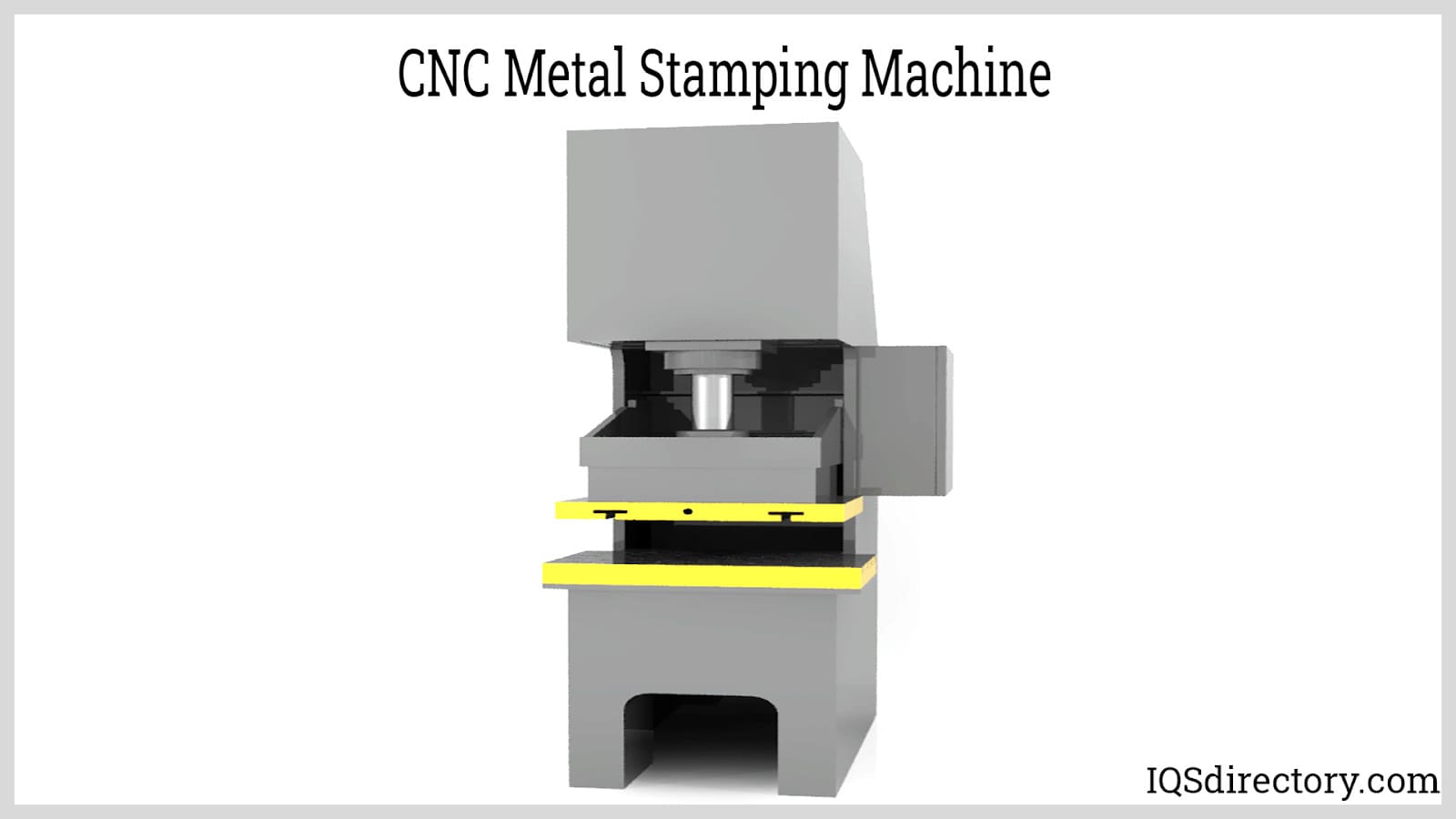 Metal stamping machines can cast, punch, and deform metals using a computer program or computer numerically controlled (CNC) for accurate parts.
Metal stamping machines can cast, punch, and deform metals using a computer program or computer numerically controlled (CNC) for accurate parts.
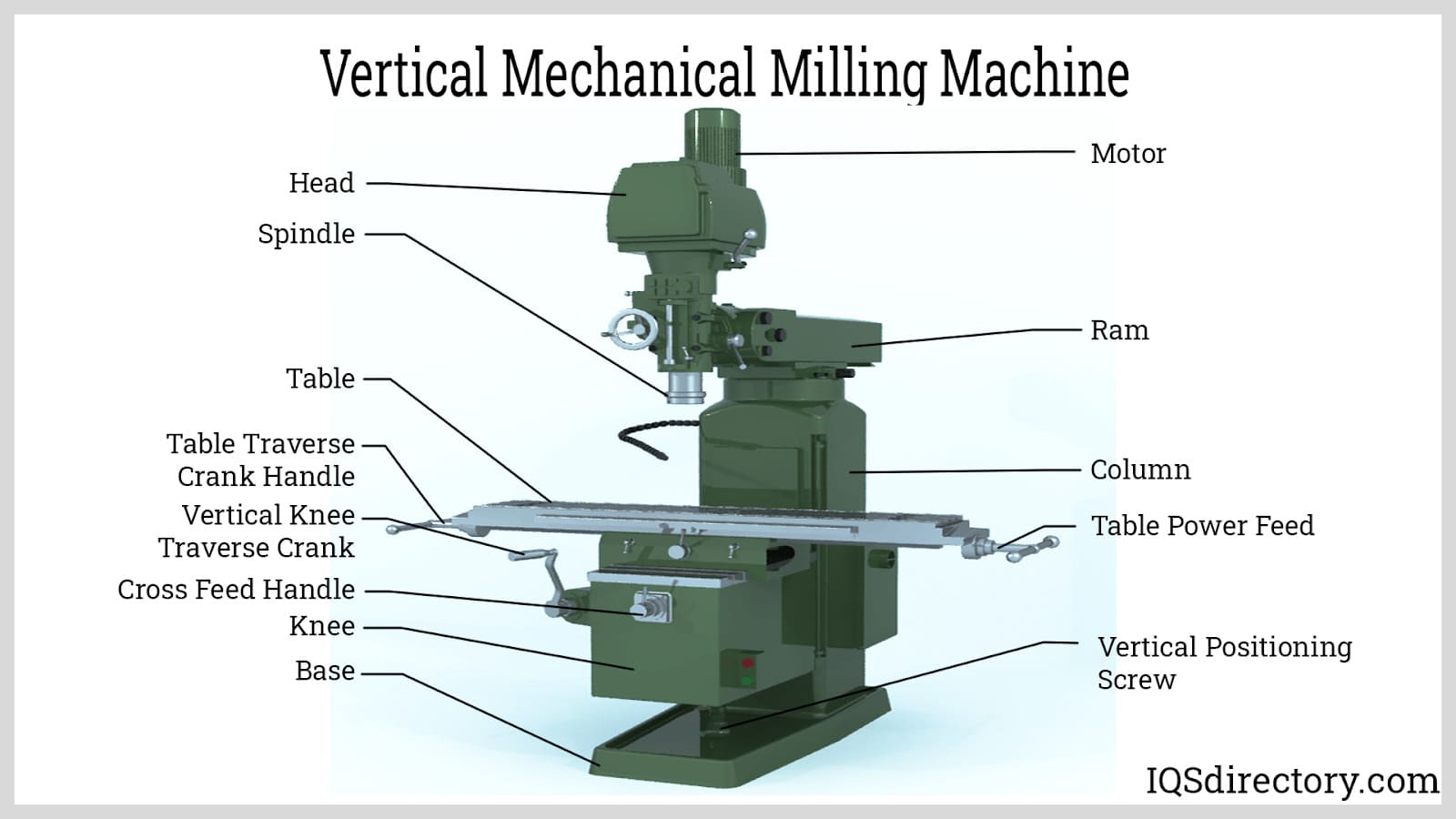 Vertical milling machines uses precision to shape metallic material.
Vertical milling machines uses precision to shape metallic material.
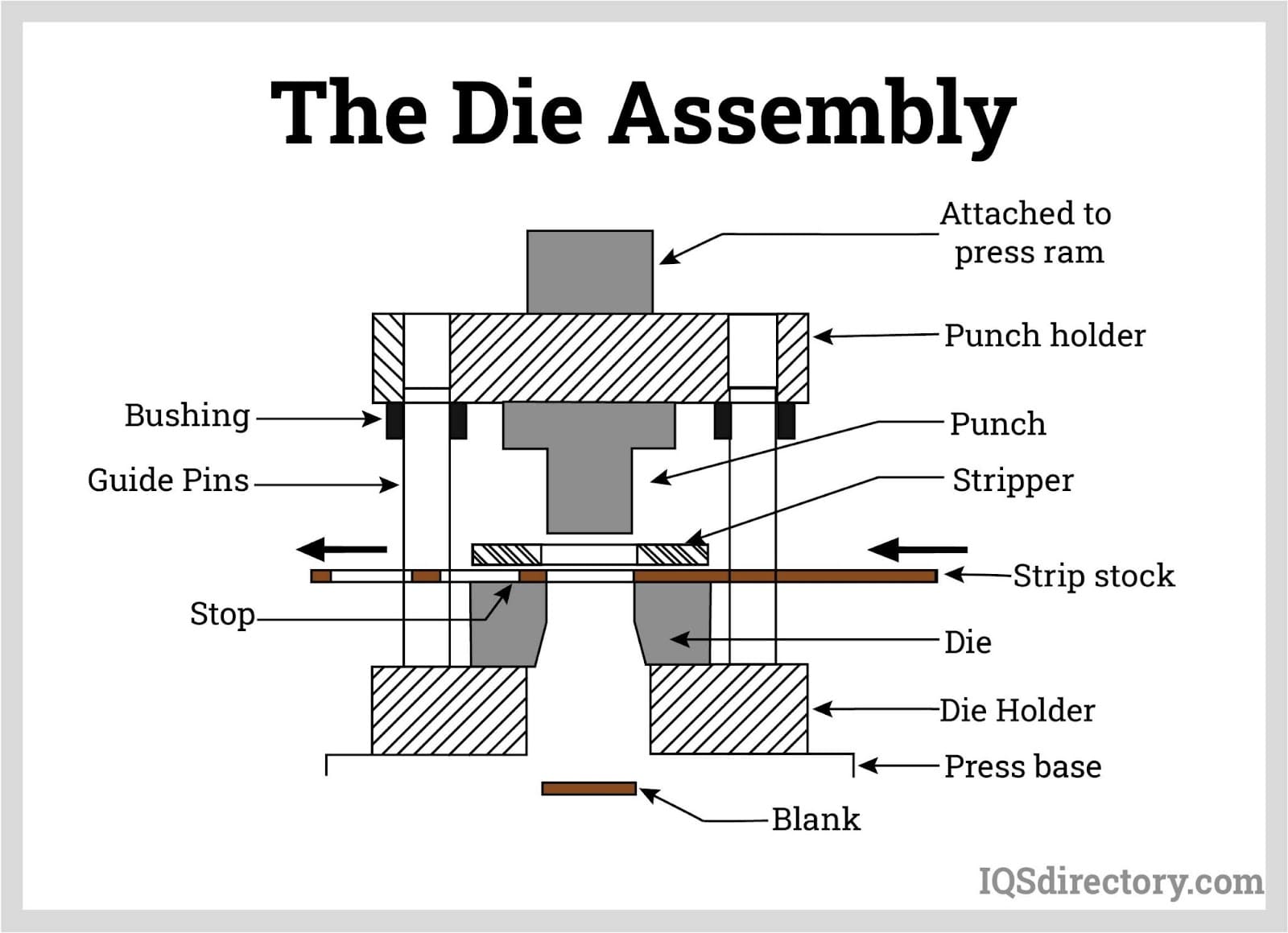 Dies are sets of tooling used to shape material to create specific customized parts.
Dies are sets of tooling used to shape material to create specific customized parts.
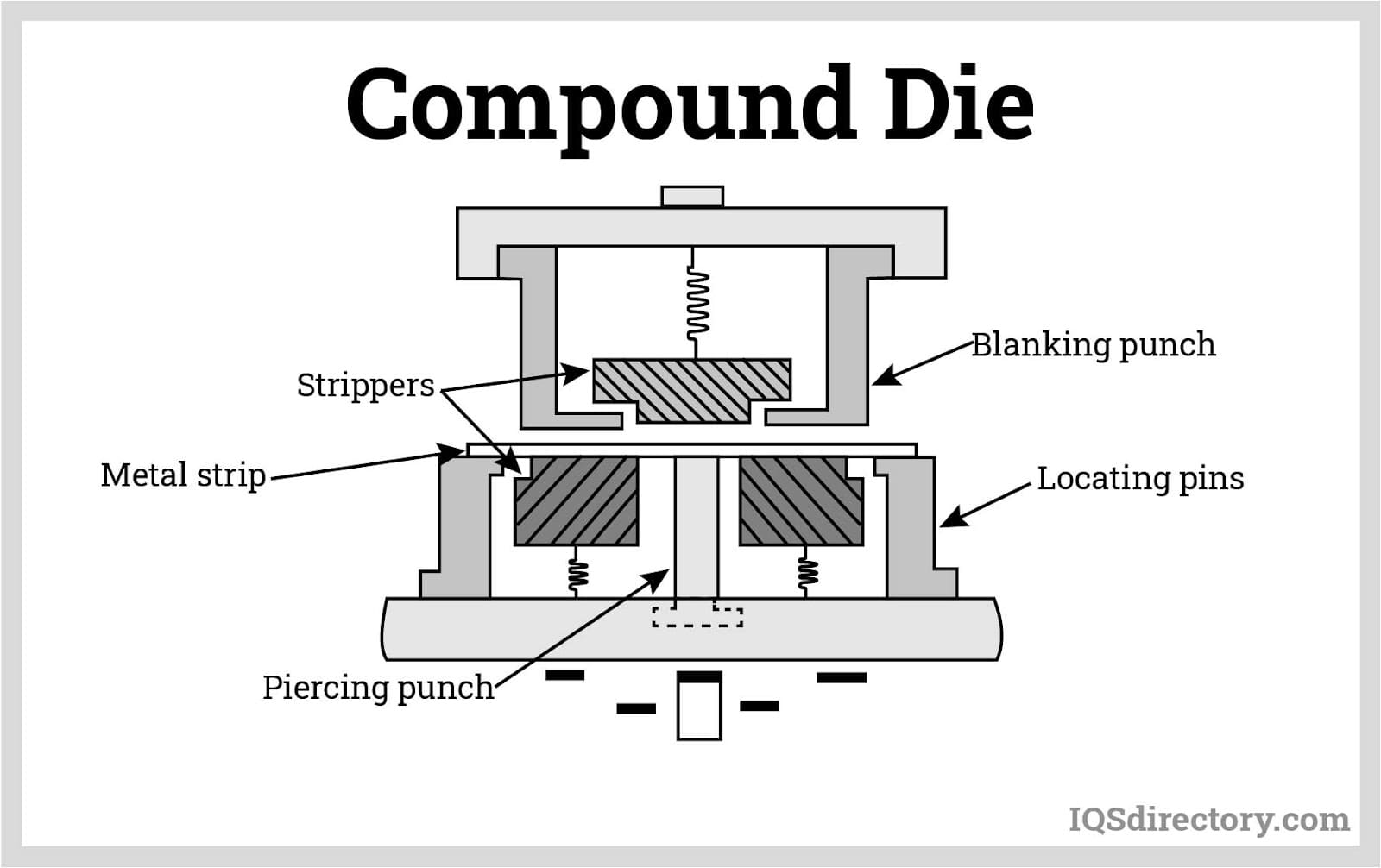 Compound dies perform more than one cut per stroke.
Compound dies perform more than one cut per stroke.
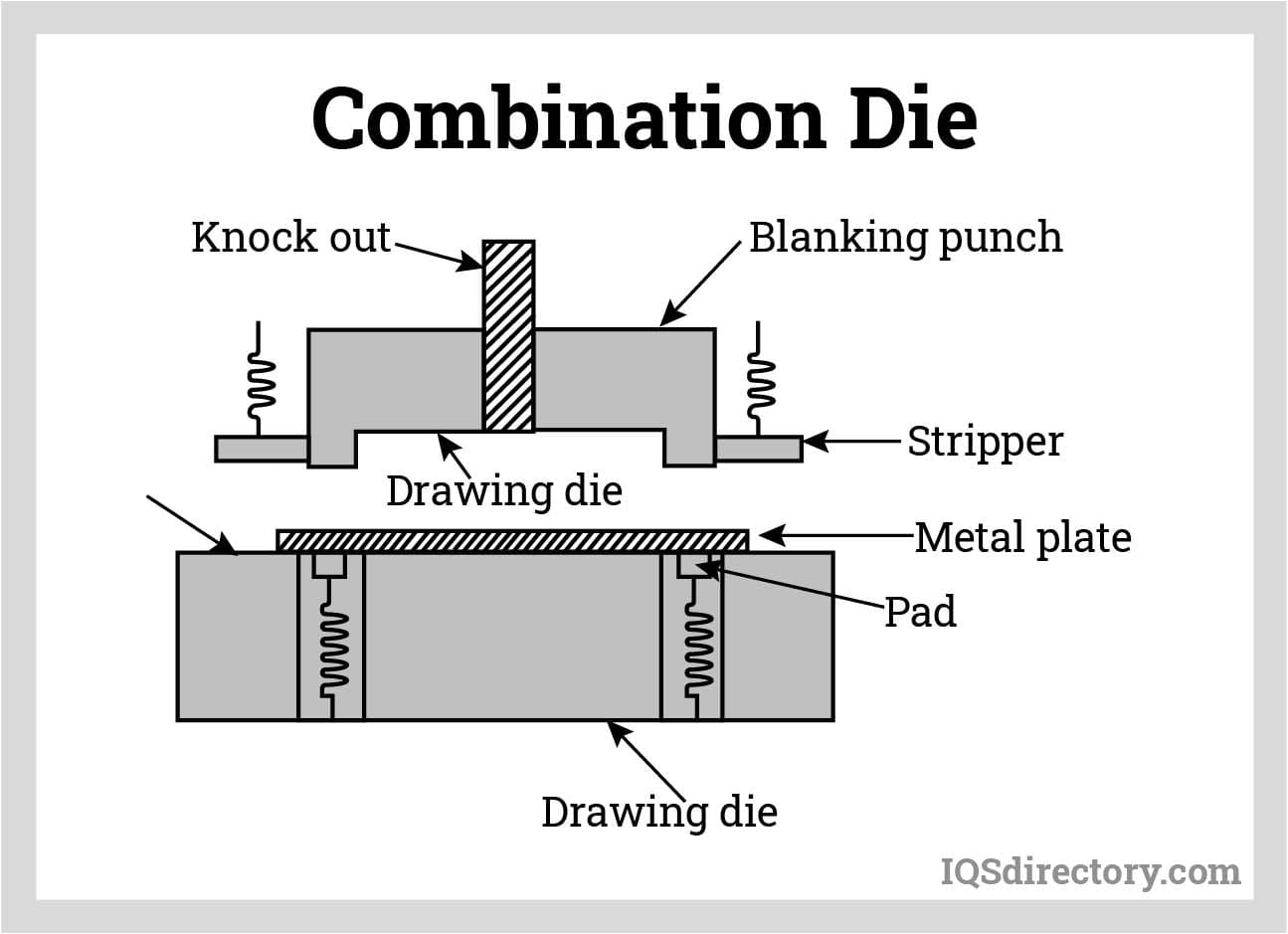 Combination dies are capable of performing more than one cutting and forming operations with a single stroke.
Combination dies are capable of performing more than one cutting and forming operations with a single stroke.
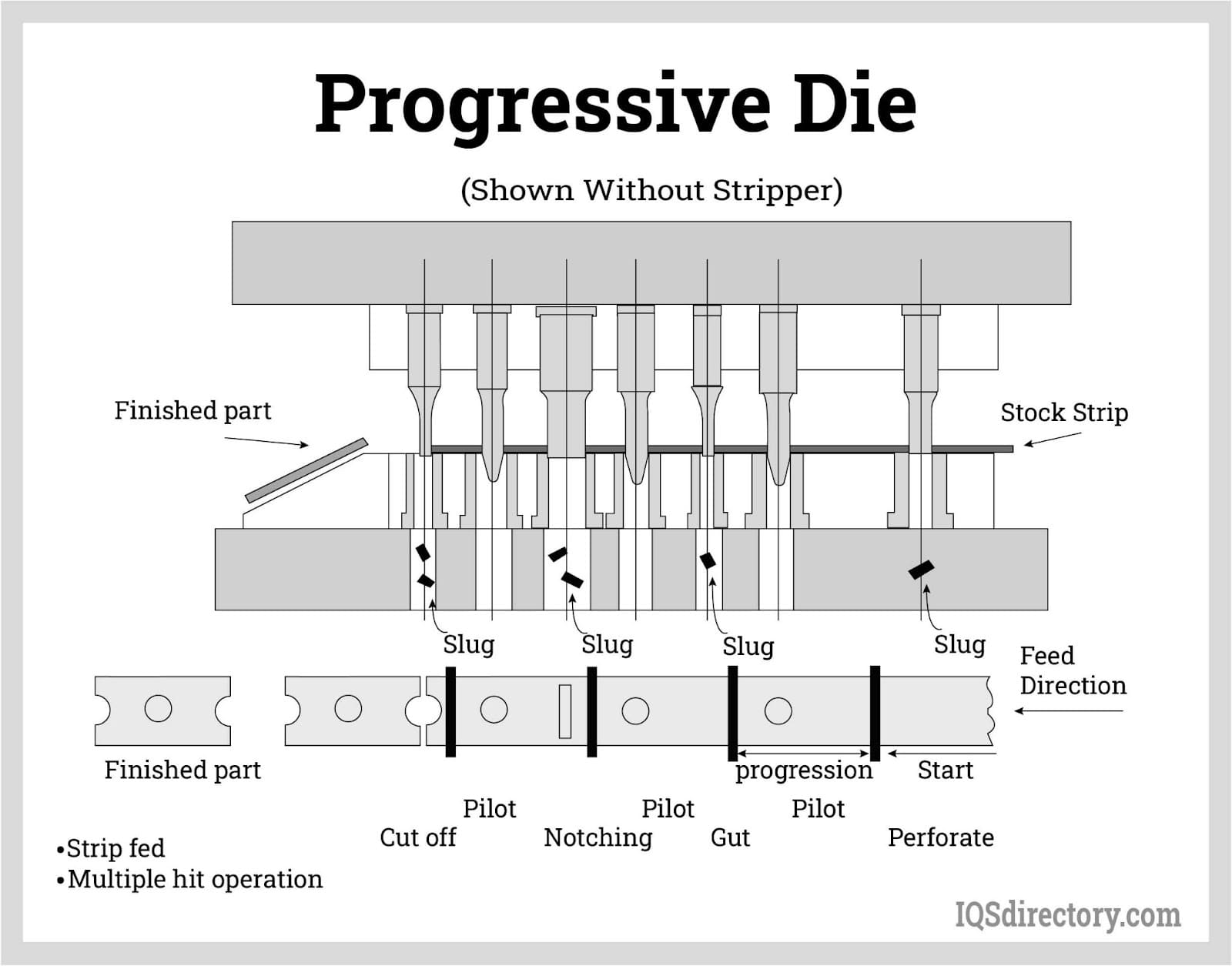 Progressive dies are used to gradually form a workpiece by passing through the series of stations arranged within the die according to the sequence of steps.
Progressive dies are used to gradually form a workpiece by passing through the series of stations arranged within the die according to the sequence of steps.
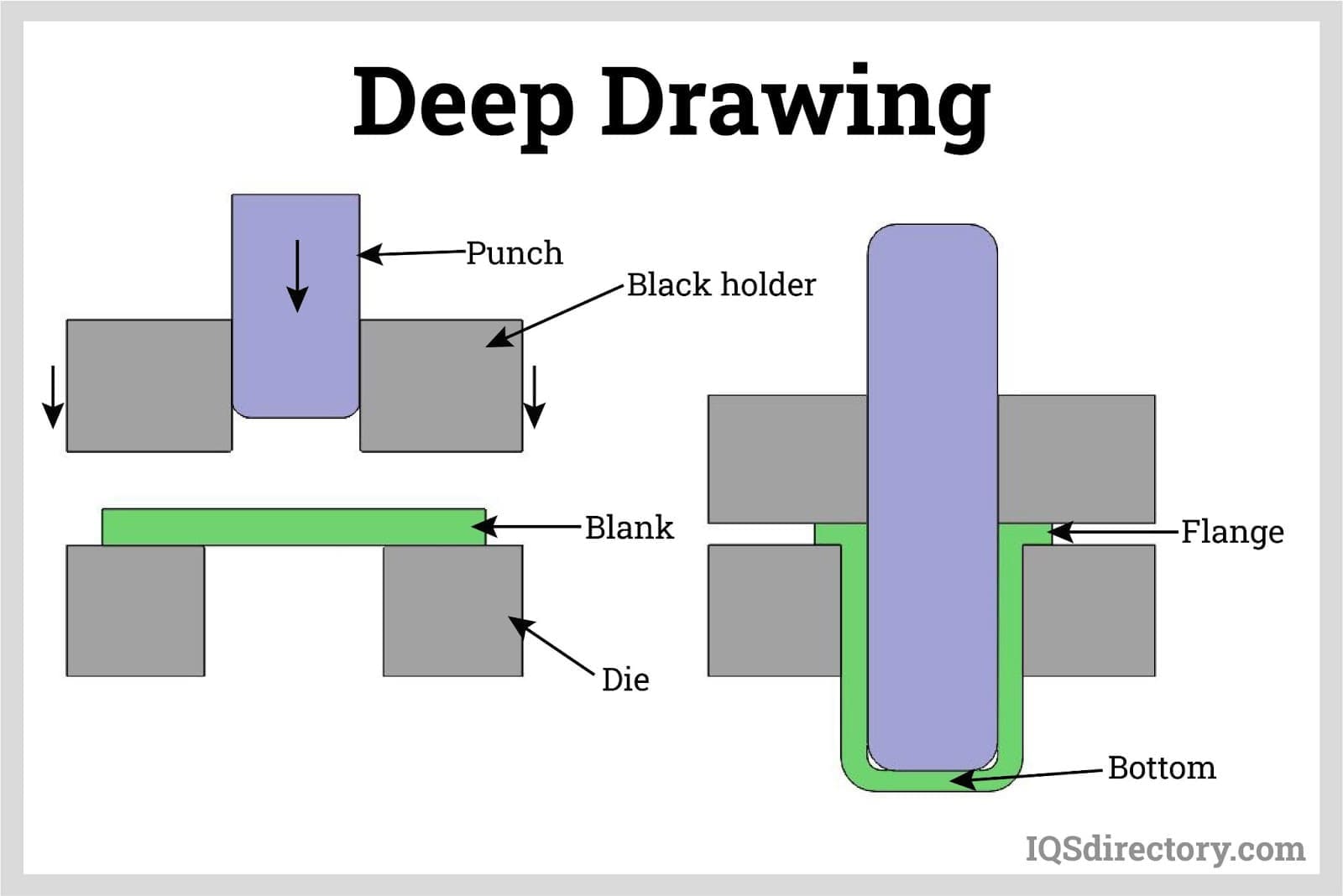 The Drawing process forms a blank into a hollow edge with a seamless edge and parts with several diameters.
The Drawing process forms a blank into a hollow edge with a seamless edge and parts with several diameters.
The metal stamping process utilizes a wide range of materials, each selected for its unique properties and suitability for specific applications. Common materials include steel, aluminum, zinc, nickel, titanium, brass, copper, and various alloys such as beryllium copper, each contributing distinct mechanical and chemical characteristics to stamped products.
- Steel
- Renowned for its exceptional tensile and yield strength, steel offers excellent corrosion resistance, superior thermal conductivity, and overall durability. These attributes make it a preferred choice for demanding applications requiring structural integrity and longevity.
- Aluminum
- Lightweight and highly corrosion-resistant, aluminum is a nonmagnetic metal with outstanding electrical and thermal conductivity. Its malleability and softness allow for intricate forming, making it ideal for applications where weight reduction and conductivity are crucial.
- Zinc
- While zinc on its own is brittle and difficult to work with, it serves as an excellent alloying element, enhancing corrosion resistance and galvanization properties in combination with other metals.
- Nickel
- Best known for its strong corrosion resistance, nickel also exhibits favorable ductility and magnetic properties. It is an essential component in numerous alloys, including brass, contributing to enhanced strength and durability.
- Titanium
- Titanium is an exceptionally strong yet lightweight metal with a superior strength-to-density ratio. Its high resistance to corrosion and ability to form alloys with other metals make it invaluable in aerospace, medical, and military applications, where performance and reliability are critical.
- Brass
- A combination of copper and zinc, brass is often used for decorative metal stampings due to its appealing aesthetic qualities. While aluminum can be added to enhance its corrosion resistance, brass is not ideal for heavy-duty industrial or outdoor applications requiring extreme durability.
- Copper
- Soft, malleable, and highly formable, copper is an excellent material for stamping due to its outstanding thermal and electrical conductivity. It is also the base metal for various alloys, including brass and beryllium copper, expanding its range of applications.
- Beryllium Copper
- As the strongest of all copper-based alloys, beryllium copper is known for its ductility, weldability, and machinability. It resists non-oxidizing acids such as hydrochloric acid and withstands galling, abrasive wear, and plastic decomposition products. Heat treatment further enhances its strength, durability, and electrical conductivity, making it a premium choice for high-performance metal stampings.
The metal stamping process involves pressing a flat sheet of metal into precise shapes based on the stamp die design. This technique enables manufacturers to create a wide range of components with high accuracy and repeatability.
- During press operation, the slide (or ram) moves in a controlled motion toward and away from a fixed platform known as the press bed. The stamp die (or die stamp), a specialized press tool featuring a precisely designed cavity, forms metal parts from the inserted sheet metal. The upper die component attaches to the press slide, while the lower component secures to the press bed.
- A critical die component, the punch (or punch press), performs the shaping operation by forcing the sheet metal through the die cavity. This punching process can be executed as either a single-stage or multi-stage operation. In single-stage stamping, each stroke of the press produces a completed metal form. In contrast, multi-stage stamping—often utilizing progressive stamping—progressively shapes the metal sheet at various angles, refining the form in multiple steps until the final shape is achieved.
- Once the metal stampings are formed, they often undergo secondary processes to enhance their properties, functionality, and finish. These processes include plating, cleaning, heat treating, and deburring, each serving a distinct purpose in improving the final product.
Plating enhances corrosion resistance, solderability, and wearability. Common plating materials include gold, palladium, nickel, and tin. Some metals can be pre-plated before stamping to eliminate the need for post-stamping plating.
Cleaning, also referred to as degreasing, removes oils and films that may remain on the metal after stamping.
Heat treating processes strengthens the metal stamping by altering its internal structure. Stamping is typically performed on the metal while in a softer state, preventing cracking before it undergoes heat treatment to achieve the desired hardness.
Deburring eliminates sharp edges and imperfections, ensuring a smooth and safe finish. This process can be performed using abrasives or chemical treatments, depending on the material and application.
When developing a metal stamping process, manufacturers must carefully evaluate several key design factors. These include the desired shape and size of the component, the required material thickness, and the precision tolerances necessary for functionality. Additionally, manufacturers must ensure compliance with industry standards and consider property preferences such as hardness, corrosion resistance, and durability.
To optimize the design process, many companies employ stamping simulation technology before constructing their metal stampings. This advanced software calculates the forming process of a specific sheet metal part and identifies potential defects such as wrinkles, splits, material thinning, and springback. By simulating the sheet metal forming process in a virtual environment, tool and die makers can evaluate the likelihood of success without incurring the costs of producing an actual tool. The results allow manufacturers to compare alternative designs, refine part geometry, and enhance efficiency—ultimately lowering production costs and improving quality.
Following the stamping simulation, manufacturers create a precise metal mold, or die, shaped with exact dimensions and bends to achieve the desired final product. Since dies can be reused multiple times, they offer efficiency and consistency in mass production. If the stamped part requires additional properties beyond what the initial machining provides, secondary processes can be applied. For example, manufacturers may plate a part post-stamping to enhance its corrosion resistance, ensuring long-term durability in harsh environments.
- Stamping Press
-
A stamping press performs metal forming with precision, speed, and controlled force. These presses can operate as mechanical, hydraulic, or hybrid presses, each offering unique advantages.
- Mechanical Press: Stores energy in a flywheel, which transfers force to the crankshaft, electric shaft, or eccentric gear.
- Hydraulic Press: Uses hydraulic pressure to control the movement of one or more rams in a preset sequence.
-
Both press types are available in a variety of sizes, ton capacities, stroke lengths, and operating speeds, making them highly customizable for different production requirements.
- Gap Frame
- A mechanical press typically used in applications where stock metal is fed manually. Straight-frame presses are better suited for progressive die and transfer die forming applications, ensuring higher precision and automation capabilities.
- Hydraulic Press
- Operates using hydraulic pressure to apply controlled force throughout the stroke. Available in various frame types, including C-frame, straight-side, H-frame, and four-column designs, these presses can deliver full power at any stroke position. Ideal for deep draw operations, precision stamping, high-tonnage blanking with long feed lengths, and short production runs, hydraulic presses offer repeatable pressure control rather than relying on stroke depth consistency.
- Progressive Press
- Designed for high-volume manufacturing, progressive presses feature multiple stamping stations that incrementally shape metal parts as a metal coil moves through the press. The final step involves cutting and separating the completed part, ensuring a continuous, automated production flow.
- Transfer Press
- Like progressive presses, transfer presses also contain multiple stations, but instead of working on a continuous coil, they handle separate sheet metal pieces that move from one station to the next. This method allows for greater flexibility in part design and accommodates complex geometries.
- Fourslide Press
- A highly versatile stamping machine with four moving slides that simultaneously shape parts along multiple axes. This automation allows for intricate cutting, bending, and forming operations in a single stage, making it ideal for manufacturing detailed components.
- Variations and Similar Processes
- Squeezing
- This technique involves molding a metal plate into the desired shape by applying pressure within a die. Unlike traditional stamping, which causes high wear and tear on dies, squeezing is cost-effective and produces smooth, vertical sides without tearing, eliminating the need for additional machining operations.
- Pinch Trimming
- A metal cutting technique used in stamping operations to trim the vertical walls of stretched or deep-drawn vessels. During pinch trimming, the metal is pinched between two hardened die sections, creating a clean edge with no shearing or fracturing—an essential step in deep-drawn can manufacturing.
- Bending
-
A metal forming process that reshapes metal along a straight axis. Different bending methods are used based on material properties and application requirements:
- Wipe Bending: A commonly used method for making metal clips but is unsuitable for high-strength metals or precision bends.
- V-Bending: Achieves a specific V-angle with less force, improving accuracy and efficiency.
- Forging
- A metal shaping process that uses compressive forces from a powered hammer or die to create strong, durable components. As one of the oldest metalworking techniques, forging produces stronger parts than casting or machining. It is classified based on processing temperature:
- Cold Forging: Performed at room temperature for high-strength parts.
- Warm Forging: Conducted at moderate temperatures to balance formability and strength.
- Hot Forging: Uses extreme heat for maximum material flexibility, making it ideal for aerospace and automotive applications.
- Line Die Method
- This process is used for large parts that cannot be efficiently manufactured in a single press cycle. It relies on manual or robotic loading of stamping tools, making it cost-effective for low-production runs and oversized components. The simplicity of line die operations allows for easy part handling and complex shape formation.
- Transfer Die Method
-
In this method, custom line dies are arranged in a structured sequence within a single press. Unlike traditional line dies, transfer rails help move metal parts between stations, improving efficiency.
- Handles large parts quickly using automated rail movement.
- Allows for part rotation during transfer to accommodate complex geometries.
- Programmable for multiple part variations, supporting different press speeds and stroke lengths.
- Progressive Die Method
- Also known as progressive stamping, this is the fastest and most automated metal stamping method. It operates by linking metal parts together using a strip carrier, which moves through a series of precisely timed stamping stations.
For the best metal stamping results, selecting the right manufacturer is essential. With so many options available, finding one that aligns with your specific needs ensures a smooth and efficient production process. The ideal manufacturer is one that delivers high-quality stamped parts, meets your required specifications, and provides reliable service within a reasonable lead time—all while staying within budget. A trustworthy manufacturer does not cut corners for profit but instead prioritizes customer satisfaction, consistently working to meet and exceed expectations.
Beyond cost and quality, expertise and experience are critical factors. The manufacturer should have extensive knowledge of metal stamping processes, materials, and industry standards. Additionally, proximity plays a role in logistical efficiency; working with a manufacturer that can ship to your location promptly reduces wait times and potential supply chain disruptions. To simplify the selection process, browse manufacturers who have demonstrated their commitment to precision, quality, and customer service. The manufacturers we list have been vetted for their reliability and dedication to excellence in the metal stamping industry.
- Alloy
- A metal compound consisting of two or more metallic elements or a combination of metal and non-metal elements. The resulting material exhibits unique properties that differ from its individual components.
- Annealing
- A heat treatment process used in metal stamping to soften metal by heating and then gradually cooling it, improving its ductility and reducing internal stress.
- Base Metals
- Common, cost-effective metals such as aluminum, zinc, lead, nickel, and tin. These metals are more prone to oxidation compared to precious metals.
- Blankholder
- A mechanism in metal stamping that holds the metal blank in place to prevent movement during the drawing process.
- Blanking
- A metal stamping process in which predetermined shapes are punched, cut, or sheared from sheet metal stock.
- Bottoming Stamp
- A stamp or weld mark that identifies a formed metal piece as belonging to the bottom of a die.
- Brazing
- A joining process in which two metals are bonded by filling the space between them with a nonferrous filler metal with a lower melting point than the base metals.
- Burrs
- Unwanted jagged edges or protrusions on the surface of metal stampings, typically formed during cutting or punching operations. Burrs must be removed through deburring processes.
- Cam
- A mechanical component that moves or operates at an angle to the stroke of a stamping press, assisting in precision forming.
- Column Press
- A four-post, single-slide press used in metal stamping operations.
- Compound Die
- A die that performs multiple stamping operations, such as blanking, piercing, and forming, within a single press stroke.
- Crank Press
- A mechanical stamping press in which motion is driven by a crankshaft.
- Cup
- A deep-drawn, cylindrical sheet metal part that is closed on one end, commonly produced in the initial stages of deep drawing operations.
- Deburr
- A finishing process that removes burrs and rough edges from stamped metal parts using abrasives or chemical treatments.
- Dope
- A lubricating compound applied to metal stock to facilitate forming and prevent damage during the drawing process.
- Draw Bead
- A rib-like projection on a die's draw ring or hold-down surface, used to regulate metal flow during deep drawing, particularly for irregularly shaped stampings.
- Ductility
- A metal’s ability to undergo bending, stretching, or deformation without breaking.
- Deep Drawn Stampings
- A metal forming process that shapes sheet metal into a three-dimensional configuration. To qualify as deep-drawn, the depth of the part must exceed its diameter.
- Eyelets
- Small metal rings used to reinforce punched holes in thin materials.
- Ferrous Metal
- A metal containing significant amounts of iron, such as steel, which provides strength but is prone to rust unless treated.
- Fourslide Stampings
- A specialized stamping process used for creating complex parts requiring bends greater than 90 degrees. A fourslide mechanism precisely guides the forming tool into position for fast, repeatable production.
- Ferrules
- Metal sleeves used to fasten, reinforce, or join materials together.
- Hard Tooling
- Also known as dedicated tooling, this process is designed for high-volume production of a single, specific part configuration.
- Heat Treating
- A secondary operation in metal stamping that enhances the strength and hardness of stamped components through controlled heating and cooling cycles.
- Insert Molding
- A process in which molten plastic is injected around metal stamping parts to create a single, integrated component.
- Lead Time
- The total time required to manufacture and deliver a product, from order placement to final availability.
- Mechanical Press
- A stamping press that relies on mechanical motion, using a shaft-driven system to apply force to the punch.
- Metal Washers
- Flat, disk-shaped components used to distribute the load of a fastener over a larger surface area, reducing stress and preventing damage to materials.
- Non-Ferrous Metal
- A metal that does not contain significant amounts of iron, such as aluminum, copper, or zinc, making it more resistant to corrosion.
- Notching
- A cutting process that removes corners or edges from a metal blank to achieve the desired final shape.
- Plating
- A secondary finishing process in which a thin metal coating is applied to a stamped part via an electrical current to enhance corrosion resistance and improve appearance.
- Precious Metals
- High-value metals such as gold, silver, and platinum, known for their superior resistance to oxidation and corrosion.
- Punch Press
- A standard stamping press that reshapes metal through the application of compressive force.
- Secondary Operations
- Post-stamping treatments such as cleaning, heat treating, plating, and deburring that refine or enhance the properties of stamped parts.
- Soft Tooling
- A tooling approach designed for flexibility, allowing manufacturers to produce multiple part configurations within a single setup.
- Stroke
- A complete cycle of movement in a stamping press, from initial force application to the return to its starting position.